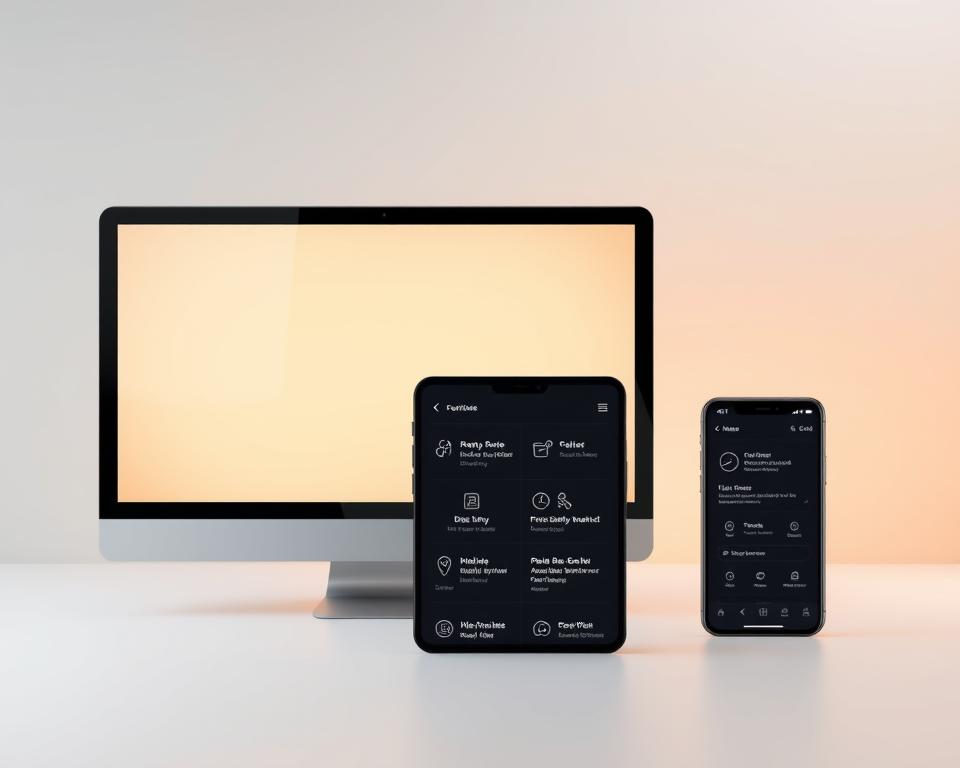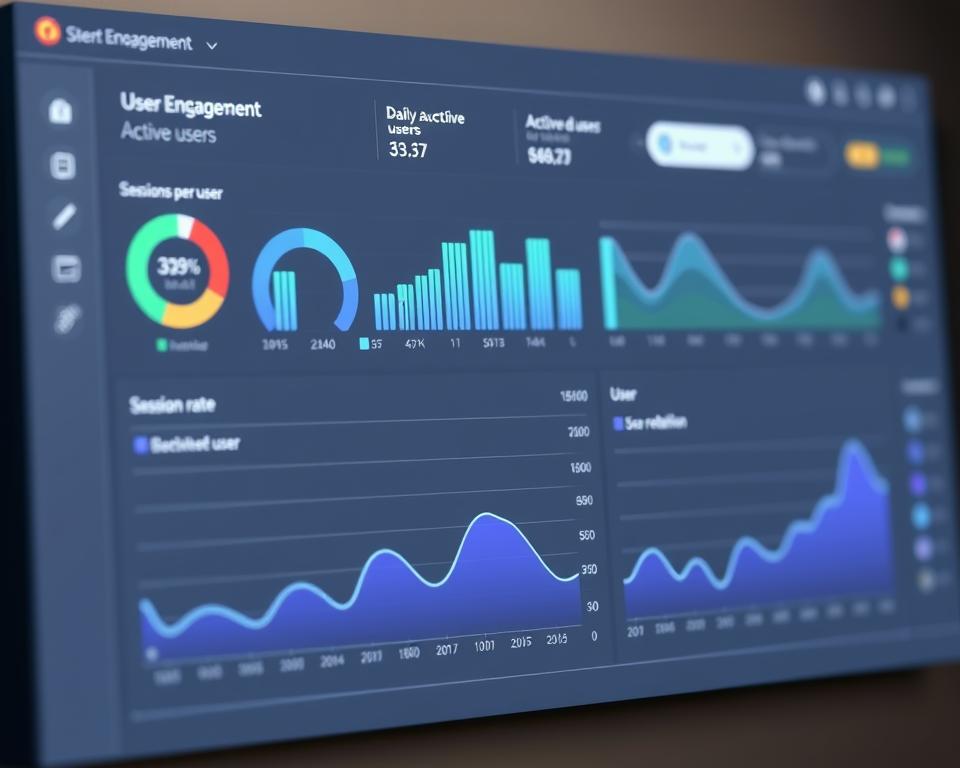Businesses face a big choice in mobile app development: progressive web apps or native apps. Each has its own good points and not-so-good points. The right choice depends on what the business needs. Progressive web apps are easy to use and accessible. Native apps offer a more personal and interactive experience.
It’s key to think about what the business wants. Do you want an app that’s easy for many people to use? Or do you aim for a deeper, more personal experience with native apps? Knowing the differences helps make a smart choice.
Looking into mobile app development, we see both progressive web apps and native apps have their strengths and weaknesses. By looking at the good and bad of each, businesses can decide which app fits their needs best.
Table of Contents
Key Takeaways
- Progressive web apps offer ease of use and accessibility
- Native apps provide a more personalized and interactive experience
- Mobile app development requires careful consideration of business goals and objectives
- Understanding the differences between progressive web apps and native apps is crucial to making an informed decision
- Both options have their own set of benefits and drawbacks
- Businesses must weigh the pros and cons of each option to make the best choice
Understanding Progressive Web Apps (PWAs)
Progressive web apps are changing how we use mobile devices. They mix the best of web and mobile apps for a smooth experience. A big PWA benefit is working offline, so users can still access content without the internet.
Comparing apps, PWAs beat native apps in many ways. They’re simpler to make and keep up, and updates don’t need new downloads. This makes PWAs great for businesses wanting a mobile presence.
Core Features of PWAs
- Responsive design
- Offline access
- Push notifications
- Native app-like experience
Technical Requirements
To make a PWA, your site must meet some tech needs. It needs a secure connection (HTTPS) and a valid service worker.
Browser Compatibility
PWAs work well with most modern browsers. This includes Google Chrome, Mozilla Firefox, and Microsoft Edge.
| Browser | Compatibility |
|---|---|
| Google Chrome | Yes |
| Mozilla Firefox | Yes |
| Microsoft Edge | Yes |
Native Apps Explained
Native apps are made just for one platform, like iOS or Android. They give a special user experience. One big native app benefit is they can use the device’s hardware, like the camera and GPS.
This lets them offer better security. They can use the device’s security features.
When it comes to app development, native apps work great with the device’s OS. This means they run fast, are easy to use, and are more fun for users of mobile apps. Some main benefits of native apps are:
- Direct access to device hardware
- High-level security features
- Seamless user experience
- Faster performance
When deciding on app development for mobile apps, think about the native app benefits. But also remember the downsides, like they cost more to make and don’t work on all platforms. Still, many businesses find native apps worth the investment.
Key Differences Between PWAs and Native Apps
When comparing apps, Progressive Web Apps (PWAs) and native apps stand out. Knowing their differences helps developers choose the right path for their projects. Costs play a big role, affecting the project’s budget.
User experience is crucial for app success. Developers focus on speed, navigation, and performance. PWAs are quicker and cheaper to develop than native apps.
Development Process
PWAs are faster and cheaper to make. They use HTML, CSS, and JavaScript, which are common and easy to learn. Native apps, however, need specific programming languages like Java or Swift, taking more time and effort.
Distribution Methods
PWAs are easy to share online, without app stores. Native apps need to go through app stores like Apple’s or Google’s, facing strict rules and reviews.
User Experience Considerations
The user experience is key to app success. PWAs offer a web-like feel, while native apps provide a deeper, platform-specific experience. Developers should weigh costs, distribution, and user experience when deciding between PWAs and native apps.
| App Type | Development Costs | User Experience |
|---|---|---|
| PWA | Lower | Web-like |
| Native App | Higher | Immersive |
Performance Comparison
When it comes to app performance, both Progressive Web Apps (PWAs) and native apps have their strengths. PWAs offer a fast and seamless experience. They can cache resources and provide offline access. Native apps, on the other hand, provide high performance and security. They are built specifically for a particular platform.
PWAs provide a consistent user experience across different devices and platforms. This is key for businesses aiming to reach a wide audience. Native apps can use device-specific features like GPS and camera capabilities. The PWA benefits include ease of development and maintenance. They also allow for updates without needing users to download a new version.
Here are some key differences between PWAs and native apps in terms of native app benefits:
- Faster loading times
- Improved security
- Enhanced user experience
- Access to device-specific features
In terms of app performance, PWAs offer a fast and seamless experience. Native apps provide high performance and security. The choice between a PWA and a native app depends on the business’s specific needs and goals. By considering the PWA benefits and native app benefits, businesses can make an informed decision.
| App Type | Performance | Security | User Experience |
|---|---|---|---|
| PWA | Fast and seamless | Good | Consistent across devices |
| Native App | High level of performance | Excellent | Enhanced by device-specific features |
Cost Implications: PWA vs. Native App Development
Choosing between a Progressive Web App (PWA) and a native app is a big decision. The costs, development process, and long-term benefits are key. These factors help decide which path to take.
PWAs are cheaper to start than native apps. They use common web tech like HTML, CSS, and JavaScript. Plus, PWAs work on many platforms, including desktop and mobile, without needing different code.
Initial Development Costs
PWAs are cheaper to make because of several reasons:
- They take less time to develop.
- They cost less to build.
- They need less setup.
Maintenance Expenses
Keeping a PWA running is also cheaper. They can be updated fast and easy. Users don’t have to download new versions themselves.
Long-term ROI Analysis
Looking at the long-term benefits is crucial. Consider:
- How much it costs to start.
- What it costs to keep it going.
- How much money it makes.
- How well users stick with it.
| Development Type | Initial Development Costs | Maintenance Expenses | Long-term ROI |
|---|---|---|---|
| PWA | Lower | Lower | Higher |
| Native App | Higher | Higher | Lower |
In conclusion, the choice between a PWA and a native app matters a lot. Think about the costs, upkeep, and long-term gains. This helps businesses pick the best option for them.
Security Considerations for Both Platforms
When we talk about security considerations, PWAs and native apps face different challenges. The main issue is app security. This means keeping user data safe and stopping unauthorized access. To protect data protection, developers need to use strong security steps like encryption and secure login methods.
Another big worry is data breaches. To lower this risk, developers should follow best practices. This includes:
- Checking user input to stop SQL injection attacks
- Using secure communication like HTTPS
- Keeping up with security updates and patches
To learn more about keeping user privacy safe in mobile app development, check out this resource. It talks about compliance and regulations.
In summary, security considerations are very important for both PWA and native app development. By focusing on app security and data protection, developers can make sure users have a safe experience and keep sensitive info safe.
User Engagement and Retention Metrics
To boost user engagement and app retention, it’s key to look at download and installation stats. Also, understanding user behavior patterns is crucial. This helps developers spot areas for betterment and improve the user experience.
Boosting user engagement can be done through push notifications, in-app messages, and tailored content. For instance, personalized content can up user engagement by 25%. To find out more about making your mobile app successful after launch, check out this resource.
Here are some important metrics to watch for when checking user behavior and app retention:
- Download and installation rates
- Active user base
- Session duration and frequency
- Retention rates over time
By keeping an eye on these metrics and tweaking their plans, developers can enhance user engagement and app retention. This leads to a more successful and lasting mobile app.
Market Reach and Accessibility
Progressive Web Apps (PWAs) have a big edge over native apps in market reach and app accessibility. They can be opened in any web browser. This means more people can use them, no matter what device they have. This seamless user experience helps them reach more people and be more accessible.
Some key benefits of PWAs include:
- They work on many platforms and devices.
- They’re easy to find and use through web browsers.
- Users can still access content even without the internet.
By offering a user experience that works the same everywhere, PWAs help businesses grow. They can reach more people and make more sales. This is because more people can use and enjoy their apps.
Development Timeline and Resource Requirements
Understanding the development timeline and resource needs is key when creating a Progressive Web App (PWA) or a native app. The development process for PWAs is quicker and less expensive. This is because PWAs use web technologies like HTML, CSS, and JavaScript. They can run on both desktop and mobile devices.
For PWA development, you need a team with web developers, designers, and testers. They should know web technologies and how to design a good user experience. The development stages include planning, design, development, testing, and deployment. Testing is crucial to ensure the app works well on various devices and browsers.
- Development timeline: PWAs can be developed and deployed quickly, with a typical development timeline of several weeks or months.
- Resource requirements: PWAs require a team of web developers, designers, and testers, with expertise in web technologies and user experience design.
- Team structure: The team structure for PWA development typically includes a team of web developers, designers, and testers, with a focus on creating a seamless and engaging user experience.
PWAs need less resources than native apps, focusing on web technologies and user experience. The time it takes to develop a PWA can vary. It depends on the app’s complexity and the team’s skills. But, PWA development is generally faster and cheaper than native app development.
Integration Capabilities with Device Features
Native apps have long been the leaders in integration capabilities with device features. They work closely with hardware like cameras, GPS, and fingerprint scanners. This is because they are made specifically for a certain device and operating system, offering a smooth user experience.
Progressive Web Apps (PWAs), on the other hand, have had to use web technologies to access device features. But, thanks to recent app development advancements, PWAs can now use many device features like native apps. For instance, PWAs can use a device’s camera and microphone for video calls and augmented reality.
Integrating device features into PWAs and native apps brings several benefits. These include:
- Enhanced user experience
- Increased functionality
- Improved engagement and retention
As integration capabilities keep improving, we’ll see more creative uses of device features in PWAs and native apps. New technologies like machine learning and artificial intelligence will open up endless possibilities for app development.
Developers can make more engaging and functional apps by understanding integration capabilities with device features. As the mobile world keeps changing, it’s exciting to see how app development and device features will come together to create new experiences.
Maintenance and Updates: A Comparative Analysis
When it comes to maintenance and updates, both PWAs and native apps face unique challenges and benefits. A big difference is the frequency of app updates. This can greatly affect how users experience the app.
Some important things to consider for maintenance and updates are:
- Update frequency: How often are updates released, and what is the process for pushing updates to users?
- Distribution challenges: What are the challenges of distributing updates to users, and how do they impact the user impact of the app?
- Resource requirements: What resources are required to maintain and update the app, and how do they impact the overall cost of the app?
It’s vital for developers and businesses to understand the maintenance and updates process for both PWAs and native apps. By focusing on app updates and user impact, developers can make an app that meets user needs and offers a great experience.
| App Type | Update Frequency | Distribution Challenges |
|---|---|---|
| PWAs | Regular updates | Easy distribution through web servers |
| Native Apps | Less frequent updates | Challenging distribution through app stores |
Business Cases: When to Choose Each Option
When it comes to app development, businesses must think about their needs and goals. Progressive Web Apps (PWAs) are great because they load fast, work offline, and offer a smooth user experience. But, native apps give direct access to device features and better security.
PWAs are perfect for companies aiming to reach many users, even those with poor internet. They’re also good for businesses needing a simple, user-friendly app. Native apps, however, are best for companies needing to use device-specific features like cameras or GPS.
Some important things to consider include:
- Development costs: PWAs are cheaper to make than native apps.
- Market reach: PWAs can be used by anyone with a web browser, while native apps need to be downloaded and installed.
- User experience: Native apps offer a deeper experience, but PWAs are more seamless and easy to use.
The choice between PWAs and native apps depends on a company’s specific needs and goals. By looking at the pros and cons of each, businesses can make a smart choice that meets their needs and provides the best user experience.
By thinking about these points and looking at the PWA benefits, businesses can develop effective app development plans. These plans can help increase engagement, conversion, and revenue growth.
| App Type | Development Costs | Market Reach | User Experience |
|---|---|---|---|
| PWAs | Lower | Wider | Seamless |
| Native Apps | Higher | Limited | Immersive |
Future Trends in Mobile Development
The world of mobile development is always changing. It’s key to know about the future trends that will shape it. New technologies like artificial intelligence, augmented reality, and the Internet of Things will change how apps are made.
These technologies will help developers make apps that are more fun and useful. For example, AI chatbots can offer personalized help, making users happier and more loyal. This is thanks to mobile development companies using these tools.
Some important trends to watch include:
- More use of cloud-based services
- Apps that work well with 5G
- More focus on keeping data safe
By keeping up with these emerging technologies, businesses can find new ways to grow. They can stay ahead in the fast-changing world of mobile development. This will help them succeed in the future trends.
| Trend | Description |
|---|---|
| Artificial Intelligence | Enables personalized user experiences and automated support |
| Augmented Reality | Enhances user engagement with immersive and interactive experiences |
| Internet of Things | Facilitates seamless connectivity and data exchange between devices |
Conclusion
Choosing between PWA and native app depends on what your business needs. Each has its own good and bad points. It’s important to know these to make a smart choice.
When making a decision, think about how long it takes to develop, the cost, and how users will feel. PWAs are often quicker and cheaper to make. But native apps give a deeper, more interactive experience.
Businesses should look at the benefits and drawbacks of each to plan their mobile app strategy. Whether you choose a PWA or a native app, focus on making it engaging, easy to use, and fast. Keeping up with new app development trends is key to success.
This way, your app will meet your users’ needs and stay competitive in the market.



















